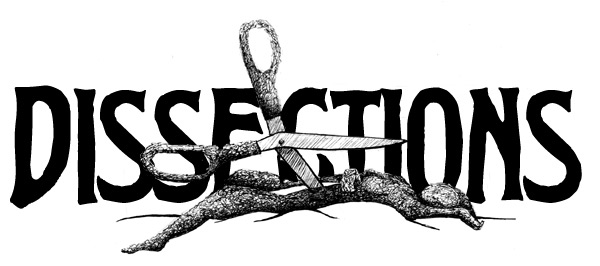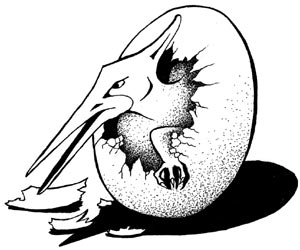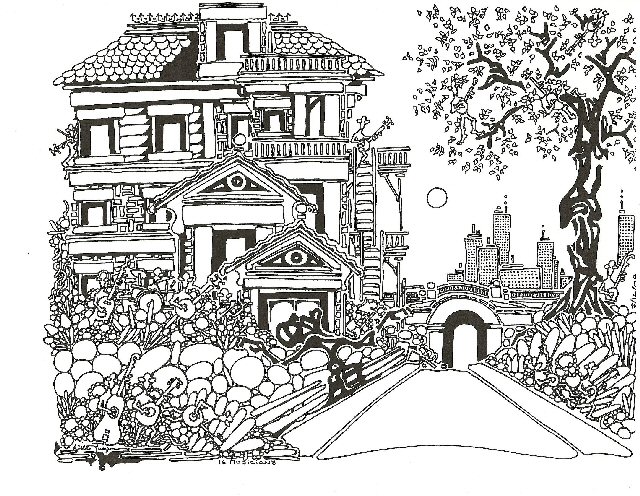[an error occurred while processing this directive]




Artwork: 16 Musicians by Will Jacques
Becoming the Other in White's "Lukundoo" and Lovecraft's "Call of Cthulhu"
Christy Hicks
One of the greatest fears of mankind is the fear of the unknown.
Howard Phillip Lovecraft comments on this fear in the beginning of
his story “Call of Cthulhu”,
“The most merciful thing in the world, I think, is the inability
of the human mind to correlate all its contents… Some day the
piecing together of dissociated knowledge will open up such terrifying
vistas of reality, and of our frightful position therein, that we
shall either go mad from the revelation or flee from the deadly light
into the peace and safety of a new dark age.” (p. 86)
As humans, we have an innate distrust or fear of “otherness”, or anything that does not fit into our preconceived notions of what is normal. One of the most horrifying situations is to be surrounded by unknown “otherness”. When everything is strange, you become the other.
Edward Lucas White explores the feeling of becoming the other in his story “Lukundoo”. The story starts with Singleton, an archeologist, as he tells a haunting tale about his research in the forbidding country of Africa. He and his colleague, Van Rieten, are exploring the wild African jungle in search of proof that pigmies exist. Another researcher, Etcham, finds them and pleads for their help. His chief, Ralph Stone, has some strange disease that looks similar to “carbuncles”, but apparently causes mental dementia. Etcham fears Stone may soon die. Despite the fact that Stone is a respected friend of Singleton and Van Rieten, they are initially reluctant to interrupt their quest for pigmies to assist him. However, when Etcham shows them a pigmy-like preserved head that he discovered in Stone’s pack, they agree to help. When they arrive at Stone’s camp, they find him sitting in a trance, babbling incoherently. That night, Singleton hears Stone speaking in two coherent voices, one being Stone’s normal voice, and the other a wheezy, high-pitched voice. At first, the voices speak as if in conversation, but an argument between the voices ensues, and they start speaking at the same time. Certain that there must be someone else in the room, Singleton rushes in. Stone’s voice is his own, but the high-pitched wheezy voice is coming from a homunculus that has grown from one of the lesions on his chest. Stone refuses all attempts at assistance, and dies. (White, pp. 714-728)
In “Lukundoo”, White exhibits how language can be an alienating and potentially horrifying element. Even though Singleton and Van Rieten were in Africa long enough that they had no problem sleeping through “the jungle noises [that] were no different than anywhere else for months past”, the complex African language is an obstacle they have not yet overcome (White, p. 724). It is difficult enough to learn one new language, but in Africa, each tribe has a distinctly different dialect, or sometimes an entirely different language. As Singleton and Van Rieten travel from tribe to tribe, they need to learn a new language all over again. When one visits a foreign country where the language is incomprehensible, he or she is left out of every conversation. It can feel as if everyone is keeping secrets. It is this very feeling that Singleton and his comrades face every day in this strange place. They have become the other.
Setting is another horrifying element that causes alienation. White prefaces “Lukundoo” in comfortable surroundings, reminiscent of an English parlour room, but quickly immerses the reader in the “deepest, dankest, drippingest forest” in Africa, where food had to be hunted, and was very hard to find (p. 715). In addition to this physically imposing setting, the natives also have strange customs. For example, nearly every tribe has a witch doctor or fetish-man that takes care of their sick, ensures the tribe’s spiritual well being, and puts curses on any that oppose them. The story’s name, Lukundoo, in fact, means “witchcraft”. (White, p. 719)
White also uses race to alienate the protagonist, by making Singleton and his colleagues the “only novelty in the country, no native we met had even seen a white man before, most had never heard of white men.” (White, p. 715) How distressing it would be to visit a place filled with people who were completely unaware of the existence of other races. Their reception must have been strange indeed.
In H.P Lovecraft’s essay, “Supernatural Horror in Literature”, he opens with “the oldest and strongest emotion of mankind is fear, and the oldest and strongest kind of fear is fear of the unknown.” Lovecraft goes on to point out that White’s “Lukundoo” arouses “darker apprehensions”. This could possibly be a play on words, signifying Lovecraft’s apprehension of the darker races (Lovecraft, Supernatural).
This emphasis on race might lead the reader to believe that part of Lovecraft’s fear of a “dark age” in his story “Call of Cthulhu” may have to do with a potential shift in the balance of racial power. If Cthulhu were to be resurrected as a supreme being, then Cthulhu’s followers would be granted positions of authority. Lovecraft repeatedly states that the Cthulhu followers are “negroes”, “mongrels”, “mixed-blooded”, “mulattoes”, “mentally aberrant” and not “sane enough to be hanged” (Lovecraft, “Cthulhu”, p. 97). A “Negro sailor” causes the death of at least two of the people investigating Cthulhu (Lovecraft, “Cthulhu”, p. 99). Perhaps Lovecraft’s subconscious fear is that Caucasians will no longer be the majority. They would become the “other”.
Lovecraft further develops this racial fear by introducing alienation caused by the unfamiliar religion of Voodoo. The Cthulhu cult is closely associated with voodoo, but is ‘”darker”. When African and Haitian slaves were imported to America, they were forced to either convert from their native Vodun to white Catholicism, or practice no religion at all. Consequently, the slaves adapted parts of Catholicism, such as worshipping the saints, to fit in with their established worship of multiple gods. Yet they maintained the connection to the Vodun religion by developing the hybrid religion Voodoo. Therefore, Voodoo as we know it today is a diluted form of Vodun, and is represented in both White’s and Lovecraft’s stories.
Lovecraft references that “New England’s traditional ‘salt of the earth’, or presumably ‘normal’ white people were immune to the effects of Cthulhu’s forced dream communications”. (“Cthulhu”, p. 89) It is the creative members of society – the artists, poets and theosophists that are deeply affected (Lovecraft, “Cthulhu”, p. 90). At the time, it was believed that creativity came from the primitive subconscious. Yet again, Lovecraft is associating Cthulhu and his fears with people who are primitive, and less accepted by society.
The beginning of “Call of Cthulhu” focuses on the recounting of a young artist’s bizarre dreams, and a bas-relief he made based on one of them. This bas-relief has hieroglyphics of an existing language that is indecipherable even to the renowned linguist, yet eerily familiar. A diary relates Professor Angell’s memories of the first time he encountered this strange language, at a meeting in St. Louis. Here, he met Inspector Legrasse, who told the gathering about his encounter with an evil cult in New Orleans. This sect was nastier than any of the Voodoo cults Legrasse had run across in his long years as an officer in the voodoo-rich city. When he and his police brigade find the evil cult, they hear the strangest noises. Legrasse says:
“There are vocal qualities particular to men, and vocal qualities particular to beasts; and it is terrible to hear the one when the sound should yield the other. Animal fury and orgiastic license here whipped themselves to daemoniac heights by howls and squawking ecstasies that tore and reverberated through those nighted woods like pestilential tempests from the gulfs of hell.” (Lovecraft, “Cthulhu”, p. 94)
Peter Penzoldt comments on Lovecraft’s unique use of language in his essay “The Pure Tale of Horror”, “The fourth group of descriptives is found almost exclusively in Lovecraft’s tales. They are really no longer words at all, but rather the phonetic transcriptions of hideous idiotic cries.” Penzolt goes on by saying Lovecraft started doing this by using the Welsh language, but soon “invented his own Welsh” (“Pure”). In “Call of Cthulhu”, the language is definitely Lovecraft’s invention, and its unique harshness inspires terror. At one point in the story, while on the recently emerged island of R’lyeh, a seaman tries to describe Cthulhu, but “there is no language for such”. (Lovecraft, “Cthulhu”, p. 105) At this point in the text, language fails! Cthulhu becomes the critical horror.
Even on Cthulhu’s island, there is a pervading sense of danger in the unknown. The very shape of the land and the effects of gravity are warped, with deadly effect. One seaman “was swallowed up by an angle of masonry which shouldn’t have been there; an angle which was acute, but behaved as if it were obtuse” (Lovecraft, “Cthulhu”, p. 105). Cthulhu and his island become the ultimate symbol of being so immersed in alien surroundings that the protagonist, and by extension, the reader becomes the other.
Works Cited
Lovecraft, H. P. (1987) ‘Call of Cthulhu’, The Dark
Descent, (ed.) David G. Hartwell (New York: Tom Doherty Associates),
pp. 85-107.
Lovecraft, H. P. (1935) ‘Supernatural Horror in Literature’, Yankee Classic, Miskatonic U., 13 December 2007, www.yankeeclassic.com
Penzolt, Peter (1952) ‘The Pure Tale of Horror’, The Supernatural in Fiction, p. 146, Literature Resource Center, Gale: Manatee Community College, Venice, 4 March 2008, keyword: Lovecraft's Call of Cthulhu.
Renfrew, Colin (1989) ‘Archaeology and Language: The Puzzle of Indo-European Origins’, Magill's Literary Annual, MagillOnLiterature Plus, EBSCO, Manatee Community College, Venice, 5 March 2008, http://search.ebscohost.com/login.aspx?direct=true&db=mjh&AN=0300302263&site=ehost-live
White, Edward Lucas (1994) ‘Lukundoo’, Great Tales
of Terror and the Supernatural, (eds.) Phyllis Cerf Wagner and
Herbert Wise (New York: Random House), pp. 714-728.